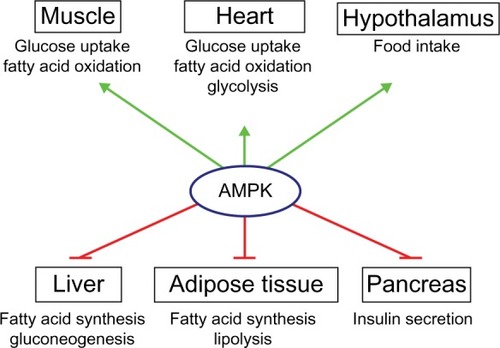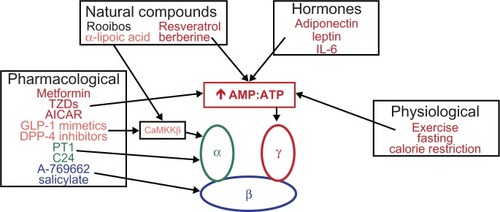Figures & data
Figure 1 Roles of AMPK in the control of whole-body energy metabolism.
Notes: Activation of AMPK (green lines) stimulates the energy-generating pathways in several tissues while inhibiting the energy-consuming pathways (red lines). In skeletal muscle and heart, activation of AMPK increases glucose uptake and fatty acid oxidation. In the liver, AMPK activity inhibits fatty acid and cholesterol synthesis. Lipolysis and lipogenesis in adipose tissue are also reduced by AMPK activation. Activation of AMPK in pancreatic β-cells is associated with decreased insulin secretion. In the hypothalamus, activation of AMPK increases food intake.
Abbreviation: AMPK, adenosine monophosphate protein kinase.
Abbreviation: AMPK, adenosine monophosphate protein kinase.

Figure 2 Physiological, pharmacological, natural, and hormonal activators of AMPK.
Notes: As discussed in the text, there are many known activators of AMPK. This noncomprehensive list highlights many of the well-established and newly discovered AMPK activators that have positive effects on T2D. Many activators activate AMPK via an increased AMP:ATP ratio (shown in red), causing AMP to bind to the γ-subunit. However, a subset of compounds stimulate AMPK activation via other mechanisms, such as binding directly to the α-subunit (shown in green), stimulating phosphorylation of αThr172 through CaMKKβ (orange), or binding directly to the β-subunit (blue). The mechanism by which rooibos activates AMPK is not known. AICAR is phosphorylated to ZMP, an analog of AMP that can activate AMPK via the γ-subunit.
Abbreviations: IL, interleukin; TZDs, thiazolidinediones; AICAR, 5-aminoimidazole-4-carboxamide riboside; GLP, glucagon-like peptide-1; DPP, dipeptidyl peptidase-4; CaMKKβ, calcium/calmodulin-dependent protein kinase kinase β; AMP, adenosine monophosphate; ATP, adenosine triphosphate; AMPK, adenosine monophosphate protein kinase; T2D, type 2 diabetes.
Abbreviations: IL, interleukin; TZDs, thiazolidinediones; AICAR, 5-aminoimidazole-4-carboxamide riboside; GLP, glucagon-like peptide-1; DPP, dipeptidyl peptidase-4; CaMKKβ, calcium/calmodulin-dependent protein kinase kinase β; AMP, adenosine monophosphate; ATP, adenosine triphosphate; AMPK, adenosine monophosphate protein kinase; T2D, type 2 diabetes.

